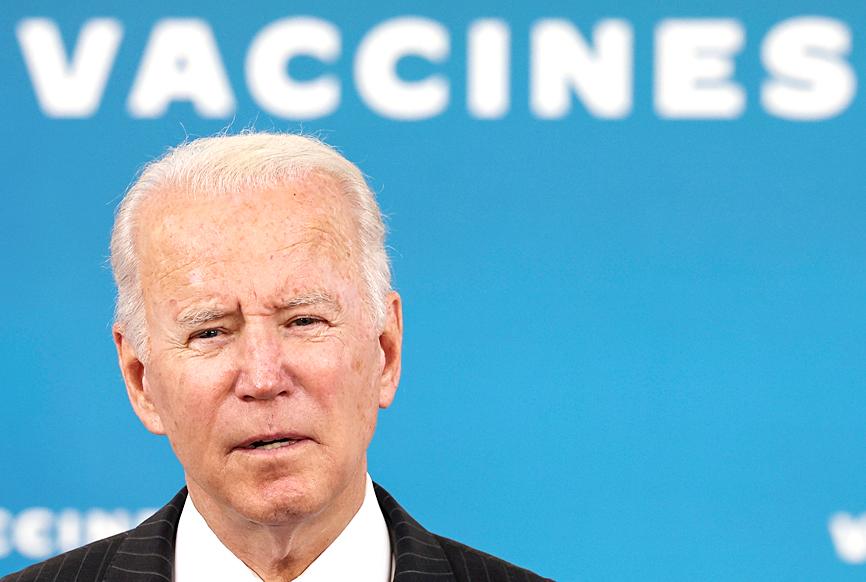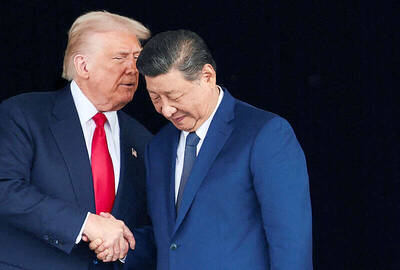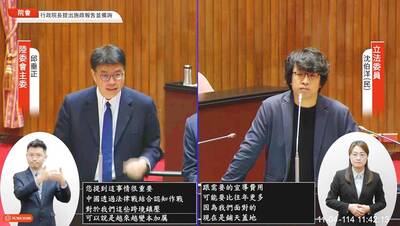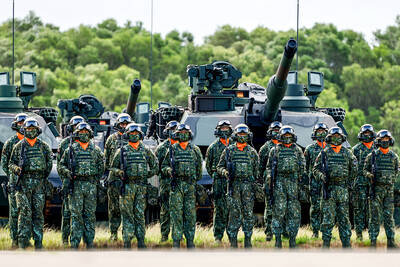US lawmakers included a statement of support for the defense of Taiwan in efforts to push back against China in a massive annual defense bill released on Tuesday that included a proposal for US$300 million to help Ukraine’s military.
The fiscal 2022 US National Defense Authorization Act (NDAA) authorizes US$770 billion in military spending, US$25 billion more than requested by US President Joe Biden and about 5 percent more than last year’s budget.
The bill — the result of intense negotiations in the US House of Representatives and the US Senate — includes a 2.7 percent pay increase for troops, and more aircraft and navy ship purchases, in addition to strategies for dealing with geopolitical threats.

Photo: Reuters
On China, the bill includes US$7.1 billion for the Pacific Deterrence Initiative and a statement of congressional support for the defense of Taiwan, as well as a ban on the US Department of Defense procuring products produced with forced labor from China’s Xinjiang region.
The US has labeled China’s treatment of its Uighur Muslim minority in Xinjiang as genocide and lawmakers have been pushing a ban on imports of products made with forced labor from Uighurs.
China dismisses the genocide charge as a slanderous assertion about conditions in Xinjiang.
The compromise NDAA omits a proposal to require women to register for the military draft that was included in earlier versions.
It includes an overhaul of the military justice system to take decisions on whether to prosecute cases of rape, sexual assault and some other major crimes out of the hands of military commanders.
The NDAA normally passes with strong bipartisan support, and the House of Representatives backed the compromise measure by 363-70 later on Tuesday.
The bill is closely watched by a broad swath of industry and other interests because of its wide scope and because it is one of the only major pieces of legislation that becomes law every year.
This year’s bill was released shortly after US President Joe Biden and Russian President Vladimir Putin held two hours of virtual talks on Ukraine and other disputes.
It includes US$300 million for the Ukraine Security Assistance Initiative, which provides support to Ukraine’s armed forces, US$4 billion for the European Defense Initiative and US$150 million for Baltic security cooperation.
It does not include a provision that would force Biden to impose sanctions over the US$11 billion Nord Stream 2 pipeline to take Russian gas directly to Germany.
The measure’s supporters argue that the pipeline would be harmful to European allies.
Lawmakers also omitted an amendment that would have banned Americans from purchasing Russian sovereign debt.
Now that it has passed the House, the NDAA must win Senate backing and be signed by Biden to become law.

CALL FOR SUPPORT: President William Lai called on lawmakers across party lines to ensure the livelihood of Taiwanese and that national security is protected President William Lai (賴清德) yesterday called for bipartisan support for Taiwan’s investment in self-defense capabilities at the christening and launch of two coast guard vessels at CSBC Corp, Taiwan’s (台灣國際造船) shipyard in Kaohsiung. The Taipei (台北) is the fourth and final ship of the Chiayi-class offshore patrol vessels, and the Siraya (西拉雅) is the Coast Guard Administration’s (CGA) first-ever ocean patrol vessel, the government said. The Taipei is the fourth and final ship of the Chiayi-class offshore patrol vessels with a displacement of about 4,000 tonnes, Lai said. This ship class was ordered as a result of former president Tsai Ing-wen’s (蔡英文) 2018

‘SECRETS’: While saying China would not attack during his presidency, Donald Trump declined to say how Washington would respond if Beijing were to take military action US President Donald Trump said that China would not take military action against Taiwan while he is president, as the Chinese leaders “know the consequences.” Trump made the statement during an interview on CBS’ 60 Minutes program that aired on Sunday, a few days after his meeting with Chinese President Xi Jinping (習近平) in South Korea. “He [Xi] has openly said, and his people have openly said at meetings, ‘we would never do anything while President Trump is president,’ because they know the consequences,” Trump said in the interview. However, he repeatedly declined to say exactly how Washington would respond in

WARFARE: All sectors of society should recognize, unite, and collectively resist and condemn Beijing’s cross-border suppression, MAC Minister Chiu Chui-cheng said The number of Taiwanese detained because of legal affairs by Chinese authorities has tripled this year, as Beijing intensified its intimidation and division of Taiwanese by combining lawfare and cognitive warfare, the Mainland Affairs Council (MAC) said yesterday. MAC Minister Chiu Chui-cheng (邱垂正) made the statement in response to questions by Democratic Progressive Party (DPP) Legislator Puma Shen (沈柏洋) about the government’s response to counter Chinese public opinion warfare, lawfare and psychological warfare. Shen said he is also being investigated by China for promoting “Taiwanese independence.” He was referring to a report published on Tuesday last week by China’s state-run Xinhua news agency,

‘NOT SUBORDINATE’: Only Taiwanese can decide the nation’s future, and people preserving their democratic way of life is not a provocation, President William Lai said Taiwan does not want China’s “one country, two systems,” and must uphold its freedom and democracy as well as resolve to defend itself, President William Lai (賴清德) said yesterday, rejecting Beijing’s latest bid to bring the country under Chinese control. The president made the remarks while attending a commissioning ceremony for Taiwan’s first battalion of M1A2T Abrams tanks in Hsinchu County’s Hukou Township (湖口). The tanks are made by General Dynamics, a major US defense contractor. China this week said it “absolutely will not” rule out using force over Taiwan, striking a much tougher tone than a series of articles in state media